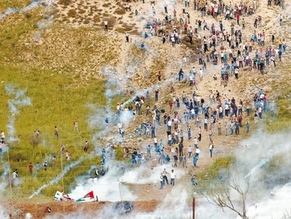|
World Jewish News

Demonstrators fleeing from Israeli army tear gas as they gather along Syria’s border with Israel near Majdal Shams during Naksa Day protests, June 5, 2011. Photo by: AFP
|
IDF fears continued Palestinian infiltration on Syria border
06.06.2011, Israel and the World Israel Defense Forces killed 22 protesters trying to cross from Syrian into Israel during Naksa Day demonstrations Sunday, according to Syrian media reports. The IDF did not give any official number of fatalities.
IDF officers fear that Palestinian refugees will continue trying to breach Israel's border with Syria, tying down large numbers of soldiers in the Golan Heights.
No Palestinians did cross the border Sunday in the second such attempt in less than a month. In contrast, hundreds surged across on Nakba Day, May 15. Syrian television reported that the IDF also injured hundreds in its effort to repulse them.
The IDF said that since all the casualties were on the Syrian side of the border it was unable to provide an exact count, but it expressed great skepticism about the Syrian figures. Soldiers fired "with precision" at the bottom half of the bodies of the protesters, the army said. Many, if not most, of the casualties occurred when a brush fire, apparently ignited by Molotov cocktails hurled by the demonstrators, set off antitank mines along the border near Quneitra at about 5 P.M.
The army accused the Syrian government of creating a deliberate provocation in an effort to divert world attention from its ongoing bloody repression of pro-democracy protests at home.
The IDF had prepared for mass infiltration attempts along every possible border Sunday, the anniversary of what Arabs term the "Naksa" ("setback" ), Israel's victory in the 1967 Six-Day War. But the main attempts occurred at two locations in the Golan, Majdal Shams and the Quneitra crossing.
Over the weekend the media had reported the cancelation of the plan to attempt a mass crossing. But Palestinian residents of Syria began streaming toward gathering points near the border early Sunday morning. Shortly after 10 A.M. two processions of about 300 people each began marching toward the border at Quneitra and at Majdal Shams, waving Syrian and Palestinian flags.
In contrast to Nakba Day - when the IDF was caught unprepared, with only a handful of troops on the normally quiet border - two full battalions were stationed at Majdal Shams Sunday, and a third at Quneitra. They were backed by police officers as well as by dogs and dog handlers from the IDF's canine unit.
The IDF had also reinforced the border with extra barbed wire and deepened the ditch between the double fence.
Syrian police officers in the area simply stood aside and let the marchers pass. The protesters were accompanied by crews from Syria's government TV station.
When the protesters neared the border at Majdal Shams, IDF officers told them in Arabic to stop, as continuing could endanger their lives. When dozens nevertheless kept going, soldiers started firing into the air. When the marchers reached the first fence, snipers were ordered to fire at their legs from about 200 meters away.
In the early afternoon, the IDF deemed the protests under control and predicted they would end in a few hours. But hundreds of protesters were still there after nightfall, throwing stones at the soldiers and trying to reach the fence.
At Quneitra, in contrast, soldiers mainly used nonlethal weaponry like tear gas and rubber-tipped bullets, with which all troops along the border had been equipped following the Nakba Day incidents. The use of nonlethal means was possible because the confrontations took place at much closer range.
The IDF acknowledged that "dozens" of marchers were hurt, but said the Syrian figure of 20 dead sounded highly unlikely.
"Our firing was measured and cautious," a senior Northern Command officer said. "We tried to avoid casualties, but at the same time, we're not willing under any circumstances to allow them to damage the border [fence] or cross it."
The use of live fire was justified, he added, because this is an international border, and "sovereignty must be upheld at any cost."
At one point a group of children marched to the fence; some of the children were injured by IDF fire.
The IDF said it arranged at least three cease-fires during the day with the Red Cross to allow the wounded to be evacuated, but each time demonstrators exploited the lull to try to break through the fence again. In one case, the IDF said, protesters seized Red Cross flags to disguise themselves as medics.
The IDF had tried to prevent the demonstrations by sending messages to Syria via UNDOF, the international peacekeeping force on the Golan. But Syrian troops continued to let hundreds of private vehicles bring in demonstrators throughout the day.
On the Israeli side, hundreds of residents of Majdal Shams, a Druze village, gathered to watch. Most did not try to interfere but some threw rocks at IDF soldiers, lightly wounding one. In response, mounted policemen charged them and fired tear gas canisters to disperse them.
Though the IDF succeeded in preventing a mass border crossing Sunday, officers voiced fears that Israel has lost the initiative: Any time the Syrian government pleases, it can let hundreds of demonstrators march on the border, cause an international incident and tie entire battalions down in the Golan, thus preventing them from training or engaging in other operational activity. Usually, this border is manned by only two or three companies of reservists.
Unlike on Nakba Day, the Lebanese border was quiet Sunday, as the Lebanese Army declared it a closed military zone. In Gaza, Hamas also kept demonstrators from approaching the border.
By Anshel Pfeffer
Haaretz.com
|
|
